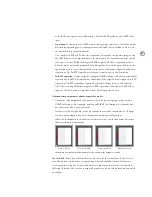
93
This option is usually not needed for draft printing on a desktop printer unless extended
character sets are in use. This option is disabled if None is chosen in the Download drop-
down list.
O t he r g rap hic s opt ions
Note that if duplicate PostScript options are available in the printer driver (by clicking the
Printer button at the bottom of the Print dialog box), for best results use the settings in the
main InDesign print dialog box as described here.
PostScript:
Specifies the job’s PostScript compatibility level. This should be set to be com-
patible with the output device or post-processor application that will receive the job. The
PostScript menu contains the following options:
•
Level 2
. Outputs jobs with speed and quality when printed to devices supporting
PostScript Level 2 or higher.
•
Level 3
. Outputs jobs at the best speed and quality, but requires a PostScript 3 RIP. This
option is not available if you targeted a PPD that only supports PostScript Level 2.
Data format:
Specifies whether InDesign sends PostScript data as hexadecimal or binary
data (including gradients and fonts). Note that support for binary printing can vary depend-
ing on the printer driver. The Data Format menu contains the following options:
•
Binary.
Sends PostScript to the printer as binary code, which is more compact (and
therefore faster) than ASCII, but which may not be compatible with all systems. This
option is an appropriate choice for shops where up-to-date hardware and networks are in
use. Note that Mac OS X 10.2 does not support binary printing, so the only data format
available for Mac OS X is ASCII unless you select PostScript file as the Printer and Device
Independent as the PPD. (You may see a Binary option in other applications under Mac
OS X 10.2, but it is likely that the data is actually being sent as ASCII.)
•
ASCII.
Sends PostScript to the printer as text. ASCII encoding represents each binary
byte of data as two hexadecimal bytes, roughly doubling the size of the data and resulting
in slower printing. Use this option when older networks, parallel printers, and multiple
platforms cause problems for binary data.






























